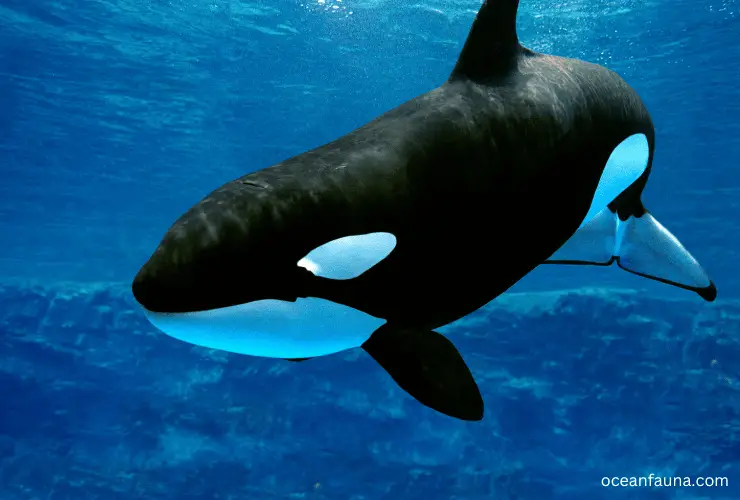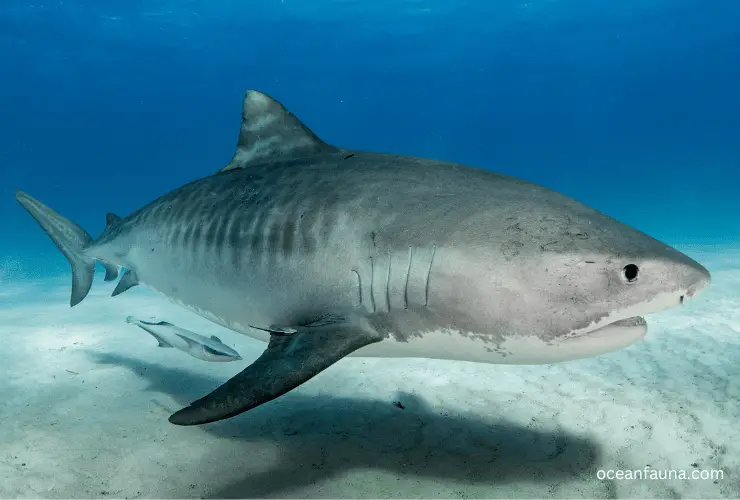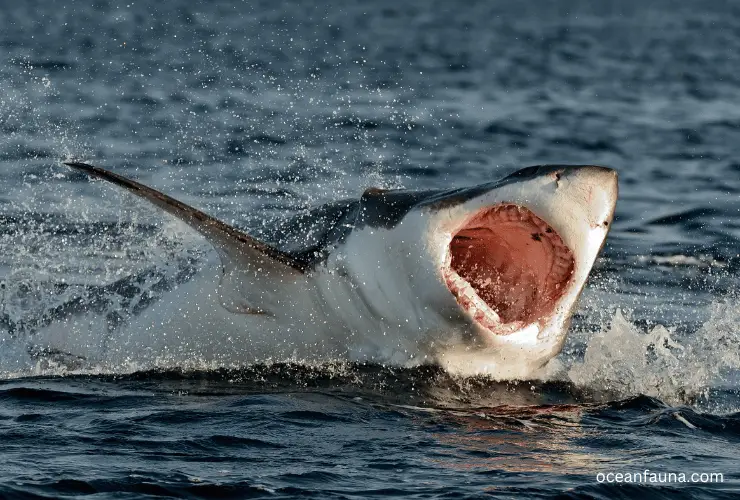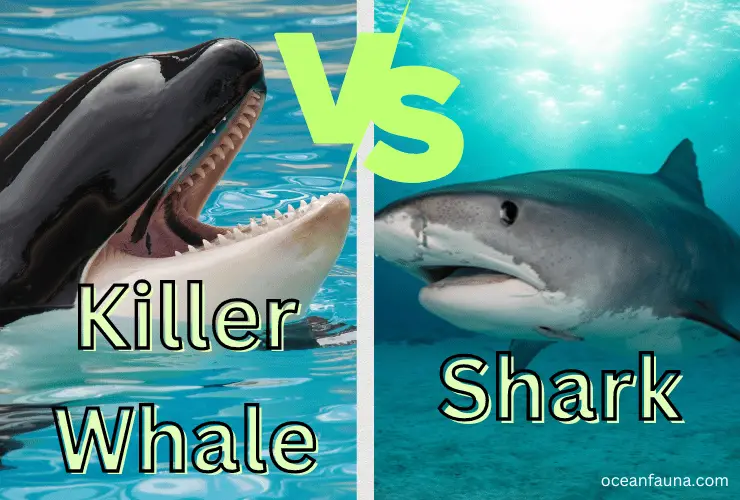If you imagine a showdown between a shark and a killer whale, then let me assure you that not even the great white shark could prevail against the killer whale. Undeniably, the Killer Whale or Orca is a champion. To explore why this species stands out from the rest, I will dive into each of its unique characteristics throughout this article.
Shark Vs. Killer Whale: Who Would Win
The killer whale will always win in a battle with sharks! Here is why-
The battle between the shark and the killer whale is a contest of strength and cunning.
The shark, one of the ocean’s largest and most feared predators, has powerful jaws filled with several rows of razor-sharp teeth for grabbing and tearing flesh. Its body is long and torpedo-shaped, allowing it to move quickly through the water. It has an excellent sense of smell, which helps it to detect prey from far away.

The orca, or “killer whale,” is a large, toothed whale that belongs to the dolphin family. It is highly intelligent and incredibly agile, with some individuals having been known to perform complex tasks such as flipping over boats or pushing sharks away from their young.
Orcas have long bodies with powerful tails that are capable of launching them up to 30 feet out of the water. They also possess sharp teeth capable of tearing through tough prey like seals.
In a fight between a great white shark and an orca, there is no question that the killer whale would emerge victorious. Orcas are much larger than great whites and can weigh up to 6 tons – almost twice as much as the largest great white ever recorded!
Additionally, orcas have stronger muscles which allow them to propel themselves through the water at speeds faster than those of any other marine mammal.
With its superior size, speed, strength, and intelligence combined with its ability to make coordinated attacks in packs (or “pods”) while targeting vulnerable areas on its prey – such as its eyes or gills – orcas are formidable adversaries for great whites when they meet in open water.
Has There Ever Been a Battle Between A Shark And A Killer Whale?
Yes, there have been a few documented battles between sharks and killer whales over the years. In 1997, an orca was seen attacking a great white just off the San Francisco coast. The attack started with a fast, forceful blow that immediately stunned the shark. Afterward, the orca relentlessly attacked the shark until it finally succumbed to its injuries and died.
Other recorded incidents include orcas chasing after bronze whaler sharks in New Zealand and an incident where an orca was observed chasing and eating a hammerhead shark in Australia.
Are Killer Whales Afraid of Sharks?
No, killer whales are not afraid of sharks at all. In fact, it has been observed that when a killer whale comes in contact with a shark, the predator-prey dynamic is completely reversed. Killer whales hunt and eat several species of shark throughout their range.

For example, they have been seen consuming Pacific sleepers and great white sharks in California waters and off South Africa. And while some individual killer whales might avoid certain sharks out of fear or caution, this is not a generalized trait among the species as a whole.
Can A Great White Shark Beat a Killer Whale Ever?
The age and size of the animals determine whether a great white shark can beat a killer whale. In general, an adult great white shark would be unable to defeat an adult killer whale due to the latter’s significantly larger size and power. A great white shark, on the other hand, can easily prey on a baby killer whale if it is in the same area as them.
Great white sharks typically prey on small fish and other small aquatic animals such as turtles. However, they will occasionally target larger prey like baby seals or dolphins that are within their reach.
In addition, great whites may also attack baby whales to protect their young from threats posed by larger predators. Great whites have been known to use their powerful jaws and fin-based propulsion systems to catch up to and attack baby whales, though this behavior is relatively rare, given that orcas usually keep their offspring away from danger whenever possible.
What Are the Differences Between Sharks And Killer Whales?
Shark Vs. Killer Whale: Anatomical Differences
Sharks and killer whales have some major anatomical differences, ranging from their size to their behavior in the water to the shapes and markings on their bodies.
Regarding size, sharks are generally smaller than killer whales, with adult orcas reaching lengths of 20-26 feet and weighing over 6 tons. Females tend to be a few feet shorter and lighter than males.
In comparison, the largest predatory shark, the great white shark, can reach up to 21 feet in length and weigh between 1,200 and 1,700 lbs. It is important to note that only filter-feeding sharks (such as basking sharks) can grow larger than the orca.

In terms of physical appearance alone, the two species are quite different from one another. Killer whales typically have a whale or dolphin-like body shape but distinguish themselves with their signature black-and-white pattern. They also have rounded snouts and long dorsal fins.
On the other hand, most predatory sharks tend to be gray in color with sharp teeth, distinct dorsal fins that may stick out of the water when swimming near the surface of the ocean, as well as other features depending on species (e.g., hammerhead shark has its unique head shape).
Sharks and killer whales differ anatomically in size and morphological characteristics. Sharks have flexible cartilage skeletons that allow for quick propulsion through the water with fewer drag forces.
In contrast, Orcas have more solid bones that give them greater power when swimming but restrict their speed when compared to sharks in open waters.

Furthermore, the orca has remarkable vision due to its bent cornea, which increases accuracy when hunting. Sharks have electroreception, which allows them to detect electrical fields from other creatures, whereas orcas do not.
Moreover, as compared to sharks, orcas have a bigger brain mass in relation to their body size. This improves their cognitive capacities, allowing them to employ successful hunting techniques such as bubble-netting prey or conducting coordinated hunts against several seals and sea lions—feats that would be too difficult for solitary shark hunters to accomplish.
Shark Vs. Killer Whale: Habitat Differences
Sharks can be found in all the oceans across the world, while killer whales are a bit more specific in their distribution. They prefer areas of cooler temperatures and often range from the poles to the tropics when looking for food and mates.
They inhabit coastal waters, estuaries, deep offshore areas, and oceanic regions around the world. Sharks tend to frequent temperate and tropical waters with deeper depths than other parts of the ocean due to their affinity for hunting prey.
Killer whales are considered one of the most adaptable marine mammals in terms of habitat preferences — they have been found living in areas from polar regions to near-tropical climates.

They are commonly seen near continental shelves and coastlines where there are plenty of food sources like fish, seals, or sea lions; however, they can also survive in the middle of open ocean areas.
In warm water regions like Australia, New Zealand, and Hawaii, many sharks can be found swimming close to shorelines during the summer months. Most shark species live closer to shore at depths extending up to 200 feet. However, some species, like white sharks, will venture into deeper waters up to 300 feet below surface level while searching for prey.
Although both are apex predators, they rarely share habitats because their diets are so dissimilar. Killer whales consume a variety of huge species, including fish, squid, dolphins, and seals, whereas most sharks consume smaller things, such as crabs or bony fish.
Because their diets differ, their ranges rarely overlap, but when they do, it is usually in warm temperate waters where both prey species are abundant, and both animals will compete for resources before moving on to different places. And in this situation, a killer whale can prey upon the sharks.
Shark Vs. Killer Whale: Breathing Differences
When it comes to underwater breathing, the shark and killer whale have two very different ways of doing so. The killer whale relies on its blowhole, located on the top of its head, for air. It takes one big breath of air before it dives into the depths for up to 10-15 uninterrupted minutes.
During that time, it can maneuver through the water in search of prey and still receive enough oxygen from its single breath.
On the other hand, the shark must rely solely on its gills to breathe while swimming through the depths. Sharks need constant motion in order to force fresh water over their gills and extract oxygen from them.
This allows them to perform fast predatory maneuvers without losing their supply of oxygen or having to surface frequently for a new breath, as the killer whale does.
Furthermore, when a shark stops moving due to ecological or environmental factors such as low oxygen levels or temperature shifts, they are forced to swim slowly until they find an area with more favorable conditions where they can increase its movement.
On the contrary, if a killer whale cannot locate food or finds itself in difficult circumstances while underwater, it can return for another breath after 10-15 minutes and then continue searching for food again with no penalty being incurred for stopping momentarily.
Shark Vs. Killer Whale: Predator Differences
When it comes to an epic animal showdown, nothing can match the sheer ferocity of a shark going head-to-head with an orca. Famous for their unmatched strength and intimidating stature as top predators in sea environments, these two species are truly awe-inspiring.

Killer whales are the largest member of the whale family and are found in all oceans of the world. They have a complex social structure and use advanced hunting techniques that make them incredibly successful predators.
A single orca can take down prey much larger than itself, such as sea lions, seals, dolphins, sharks, and even other whales. Orcas also hunt cooperatively as a pack, which gives them an advantage over most other marine predators who hunt alone or in small groups.
Sharks, on the other hand, are some of the oldest creatures on Earth that predate dinosaurs by more than 200 million years. They come in an amazing array of shapes and sizes, from tiny cookie-cutter sharks to giant whale sharks that can reach lengths of 40 feet or more!
Sharks typically feed on smaller fish but can also take down larger prey such as seals, turtles, dolphins, and even other sharks depending on their size and species.
As I said before, an orca or killer whale is the clear winner when it comes to direct confrontations between sharks and orcas.
Killer whales have been recorded preying on a variety of sharks, including hammerheads, great whites, tiger sharks, blue sharks, and mako sharks, among others, but infant orcas proceed with caution because these apex predators can fight back with strong bites!
Conclusion
Knowing that sharks can never overpower killer whales in a fight, it is nevertheless possible for a shark to overcome its foe if the orca is smaller or younger. The size and age of the combatants will ultimately determine who emerges victorious from such battles.


14 thoughts on “Shark Vs Killer Whale: Who Would Win?”